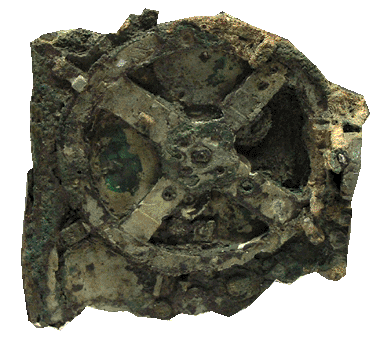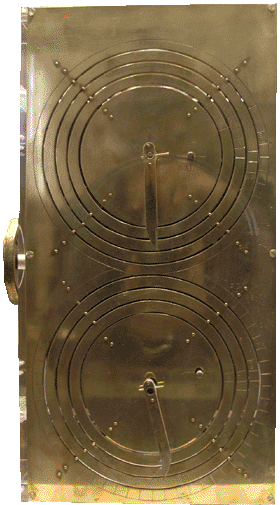pop up description layer
HOME
Cryptozoology UFO Mysteries Aviation Space & Time Dinosaurs Geology Archaeology Exploration 7 Wonders Surprising Science Troubled History Library Laboratory Attic Theater Store Index/Site Map Cyclorama
Search the Site: |
|
A mechanical computer that existed two-thousand years before the age of electronics. Who built it? One day a Greek archaeologist named Spyridon Stais was carefully going through some of the material brought up from a shipwreck. The wreck had been found accidentally two years earlier in 1900 when a group of sponge divers had been blown off course and forced to anchor at a new location near the island of Crete at a place called Antikythera. There the sponge divers started conducting business as usual. Instead of finding sponges, however, they started bringing up bits of pottery and other very old artifacts. Amazingly, what the divers had happened upon was a Roman ship that floundered at sea an estimated 2000 years earlier. The Greek government, anxious to recover what they could from the wreck, had employed the divers to take on the difficult job of bringing up artifacts from the bottom of the sea using the same methods they used to search for sponges: free dives with no breathing apparatus. It was a dangerous business. One diver died and another was permanently disabled. Still, the group managed to retrieve a treasure trove of historical objects. One of the less impressive finds was the lump of material that Stais was looking at. It appeared to be a mass of wood which was now decaying since it had been brought to the surface and started drying out. The rot seemed to have exposed something that Stais hadn't seen before: a bit of metal. Not just a bit of metal, a bit of metal that was round with teeth. A gear. Stais couldn't believe his eyes. A metal gear from a shipwreck before the birth of Christ? What was this thing? What Stais had stumbled upon was the remains of one of the world's oldest-geared devices - an analog computer - almost two millennia in age. Over the next century it would upset the archeological world's understanding about the kind of technology the ancients were capable of producing. Speculations and Reconstructions After Stais's discovery, speculation about what the device was used for echoed around the archeological world for decades. Scientists knew that the device seemed to have 32 interlocking gears and a hand crank, plus a display that showed information about the moon, sun and planets against a background of stars. The gears inside the mechanism were made of bronze and the whole device had apparently been mounted in a wooden box that measured about 13 inches high, 7 inches wide and 3 ½ inches deep. Unfortunately, much of the device however had been damaged by its time in the water, making it difficult to work out exactly how all the parts had been put together. Efforts to figure out what the thing actually did received a boost in 1971 when the mechanism was X-rayed. This enabled scientists to count the teeth on each gear and then make detailed drawings to determine how it might have worked. In 1974, Derek de Solla Price, a historian at Yale University, who had been studying the mechanism for over twenty years, published a paper showing how he thought the mechanism operated. Price wrote that the existence of the device "requires us to completely rethink our attitudes toward ancient Greek technology." Price also built a reproduction of the device now housed at the National Museum in Athens. Much of Price's work, however, was met with skepticism from other historians who advanced alternate, less-controversial theories. The existence of a device like the Antikythera Mechanism from this early a period in history simply did not match many historians' preconceived notions about the kind of technical expertise the ancients had. One skeptic, in a desperate attempt to explain how such a sophisticated object was found in the remains of a Roman ship, suggested that it was actually a device from the 18th century that had fallen overboard at some later date and onto the deck of the wreck.
Recent efforts to find out more about the device have been spearheaded by the Antikythera Mechanism Research Project, a consortium of several agencies, businesses and museums interested in finding out more about the object. The device was too fragile to be removed from its home at the National Archaeological Museum of Athens, so the Project constructed a 12-ton portable micro focus computerized tomographer that used high resolution X-rays to probe the object and create a 3-dimensional image. Two Hewlett-Packard scientists, also involved in the project, used a technique they developed involving a digital camera and fifty different lights to photograph details of the object that could not previously be seen. In 2006, the Project announced that with these tools almost 95 percent of the text engraved on the various parts of the device is now readable, giving scientists a much-improved understanding of its capabilities. Much of what Price and other researchers surmised about the device seems to be true. The mechanism was clearly an analog computer designed to allow the operator to predict the future or past positions of the sun, moon, and probably some of the planets. On the front of the device were two dials marked with the zodiac and a solar calendar, with pointers for the Sun and Moon plus a display showing the phase of the moon. On the rear of the object was displayed information about the Saros cycle (a period of around 18 years used in eclipse prediction) and the Callippic cycle (a period of about 76 years) using two ingeniously designed spiral dials. The capability of the machine has amazed scientists. It has an accuracy of one unit of error out of 860000. One researcher, Professor Mike Edmonds remarked, "This device is just extraordinary, the only thing of its kind. The design is beautiful, the astronomy is exactly right. The way the mechanics are designed just makes your jaw drop. Whoever has done this has done it extremely carefully." Built by Aliens? Who built this ingenious device? Some have gone so far as to suggest it was the work of aliens. There is no real evidence for this, of course, and historical texts do have references to devices similar in design to the Antikythera Mechanism. The Roman historian Cicero wrote about a device supposedly constructed by the Greek philosopher Archimedes which was brought back to Rome by the Roman general Marcus Claudius Marcellus after he conqured Syracuse in 212 BC. According to Cicero, he received a demonstration of the device from a descendant of Marcellus and the object displayed the motions of the sun, moon and five planets. Cecero also mentions that a similar device was built by his friend Posidonius, another Greek philospher. A millenium later the Persian scholar al-Biruni also described a device similar to the Antikythera Mechanism and included a diagram of it in a treatise written in AD 996. Though it was much simpler in design, historians have speculated that the object in the diagram was a direct descendant of the Antikythea device. Price had a theory that the Antikythera Mechanism was constructed by the Greek astronomer Geminus on the Greek island of Rhodes around 87 BC. At the time the island was a center of learning for astronomy and mechanical engineering. Engineers there were well-known for creating intricate automata (mechanical toys or tools that demonstrated basic scientific principles). The device could have found its way on board a Roman ship a decade later as part of a hoard of treasure being taken to Rome to be displayed in a triumphal parade for Julius Caesar. How was it used? This remains a matter of great speculation. Such a device would have been of great help to an astrologer in creating star charts. It could have also been used to correct calendars and set the dates of religious festivals. It might even have provided assistance in predicting what days eclipses were likely to occur. We may never know exactly who built it or what it was used for. However, it remains a testament to the engineering skills of the ancients and a warning that despite all we know about history, there are still mysteries to be solved. A Partial Bibliography Archaeology: High tech from Ancient Greece, by François Charette, Nature, November 2006, http://www.nature.com/nature/journal/v444/n7119/full/444551a.html Greatest Treasures, by Michael Bradley, Barnes & Noble, 2005. Copyright Lee Krystek 2007. All Rights Reserved.
|
|
Related Links |
|
|



 The
Antikythera Mechanism
The
Antikythera Mechanism
